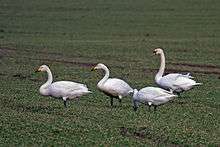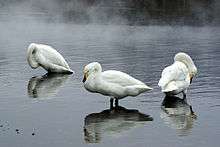Whooper swan
| Whooper swan | |
|---|---|
 | |
| | |
| Calls recorded in County Cork, Ireland | |
| Scientific classification | |
| Kingdom: | Animalia |
| Phylum: | Chordata |
| Class: | Aves |
| Order: | Anseriformes |
| Family: | Anatidae |
| Subfamily: | Anserinae |
| Tribe: | Cygnini |
| Genus: | Cygnus |
| Species: | C. cygnus |
| Binomial name | |
| Cygnus cygnus (Linnaeus, 1758) | |
 | |
| Range of C. cygnus Breeding range Year-round range Wintering range | |
| Synonyms | |
|
Cygnus ferus | |

The whooper swan (Cygnus cygnus), pronounced hooper swan, is a large Northern Hemisphere swan. It is the Eurasian counterpart of the North American trumpeter swan, and the type species for the Cygnus genus. Francis Willughby and John Ray's Ornithology of 1676 referred to this swan as "the Elk, Hooper, or wild Swan".[2]:23 The scientific name is from cygnus, the Latin for "swan".[3]
Description
The whooper swan is similar in appearance to the Bewick's swan. It is larger, however, at a length of 140–165 cm (55–65 in) and a wingspan of 205–275 cm (81–108 in). Weight typically is in the range of 7.4–14 kg (16–31 lb), with an average of 9.8–11.4 kg (22–25 lb) for males and 8.2–9.2 kg (18–20 lb) for females. The verified record mass was 15.5 kg (34 lb) for a wintering male from Denmark. It is considered to be amongst the heaviest flying birds.[4][5] Among standard measurements, the wing chord is 56.2–63.5 cm (22.1–25.0 in), the tarsus is 10.4–13 cm (4.1–5.1 in) and the bill is 9.2–11.6 cm (3.6–4.6 in).[6] It has a more angular head shape and a more variable bill pattern that always shows more yellow than black (Bewick's swans have more black than yellow). Like their close relatives, Whooper swans are vocal birds with a call similar to the trumpeter swan.

Distribution and behaviour
Whooper swans require large areas of water to live in, especially when they are still growing, because their body weight cannot be supported by their legs for extended periods of time. The whooper swan spends much of its time swimming, straining the water for food, or eating plants that grow on the bottom.[7]
Whooper swans have a deep honking call and, despite their size, are powerful fliers. Whooper swans can migrate hundreds or even thousands of miles to their wintering sites in southern Europe and eastern Asia. They breed in subarctic Eurasia, further south than Bewicks in the taiga zone. They are rare breeders in northern Scotland, particularly in Orkney, and no more than five pairs have bred there in recent years; a handful of pairs have also bred in Ireland in recent years. This bird is an occasional vagrant to the Indian Subcontinent[8] and western North America. Icelandic breeders overwinter in the United Kingdom and Ireland, especially in the wildfowl nature reserves of the Royal Society for the Protection of Birds and of the Wildfowl and Wetlands Trust.
Whooper swans pair for life, and their cygnets stay with them all winter; they are sometimes joined by offspring from previous years. Their preferred breeding habitat is wetland, but semi-domesticated birds will build a nest anywhere close to water. Both the male and female help build the nest, and the male will stand guard over the nest while the female incubates. The female will usually lay 4–7 eggs (exceptionally 12). The cygnets hatch after about 36 days and have a grey or brown plumage. The cygnets can fly at an age of 120 to 150 days.
When whooper swans prepare to go on a flight as a flock, they use a variety of signaling movements to communicate with each other. These movements include head bobs, head shakes, and wing flaps and influence whether the flock will take flight and if so, which individual will take the lead.[9] Whooper swans that signaled with these movements in large groups were found to be able to convince their flock to follow them 61% of the time.[9] In comparison, swans that did not signal were only able to create a following 35% of the time.[9] In most cases, the whooper swan in the flock that makes the most movements (head bobs) is also the swan that initiates the flight of the flock – this initiator swan can be either male or female, but is more likely to be a parent than a cygnet.[9] Additionally, this signaling method may be a way for paired mates to stay together in flight. Observational evidence indicates that a swan whose mate is paying attention to and participates in its partner’s signals will be more likely to follow through with the flight. Thus, if a whooper swan begins initiating flight signals, it will be less likely to actually carry through with the flight if its mate is not paying attention and is therefore less likely to join it.[9]
They are very noisy; the calls are strident, similar to those of Bewick’s Swan but more resonant and lower-pitched on average: kloo-kloo-kloo in groups of three or four.
Influence
Whooper swans are much admired in Europe.[7] The whooper swan is the national bird of Finland[10] and is featured on the Finnish 1 euro coin. The whooper swan is one of the species to which the Agreement on the Conservation of African-Eurasian Migratory Waterbirds (AEWA) applies.
The global spread of H5N1 reached the UK in April 2006 in the form of a dead whooper swan found in Scotland.[11]
Musical utterances by whooper swans at the moment of death have been suggested as the origin of the swan song legend.
 Whooper swan in Regent's Park, London, England
Whooper swan in Regent's Park, London, England
 Young Whooper swan at Lake Kussharo, Japan
Young Whooper swan at Lake Kussharo, Japan_1.jpg) Young Whooper swans with parents at Stawinoga ponds, Poland
Young Whooper swans with parents at Stawinoga ponds, Poland
 Mute swans with orange bills and whooper swans with yellow bills
Mute swans with orange bills and whooper swans with yellow bills
References
- ↑ BirdLife International (2012). "Cygnus cygnus". IUCN Red List of Threatened Species. Version 2013.2. International Union for Conservation of Nature. Retrieved 26 November 2013.
- ↑ Willughby, Francis (1676). Ornithologiae libri tres [Ornithology, Book Three] (in Latin). London: John Martyn.
- ↑ Jobling, James A (2010). The Helm Dictionary of Scientific Bird Names. London: Christopher Helm. p. 128. ISBN 978-1-4081-2501-4.
- ↑ Brazil, Mark (2003). The Whooper Swan. Christopher Helm Ornithology. ISBN 978-0-7136-6570-3.
- ↑ Dunning, John B. Jr., ed. (1992). CRC Handbook of Avian Body Masses. CRC Press. ISBN 978-0-8493-4258-5.
- ↑ Madge, Steve (1992). Waterfowl: An Identification Guide to the Ducks, Geese, and Swans of the World. Houghton Mifflin Harcourt. ISBN 978-0-395-46726-8.
- 1 2 Mondadori, Arnoldo, ed. (1988). Great Book of the Animal Kingdom. New York: Arch Cape Press. pp. 182–183.
- ↑ "Whooper Swan sighted in Himachal Wetland after 113 years. | Hill Post". Hillpost.in. 30 January 2013. Retrieved 5 October 2013.
- 1 2 3 4 5 Black, J. "Preflight Signaling in Swans: A Mechanism for Group Cohesion and Flock Formation" (PDF). Ethology. 79: 143–157. doi:10.1111/j.1439-0310.1988.tb00707.x.
- ↑ "Whooper Swan". wwf.panda.org. Retrieved 2 December 2016.
- ↑ "Bird flu swan was from outside UK". BBC News. 11 April 2006.
External links
| Wikimedia Commons has media related to Cygnus cygnus. |
| Wikispecies has information related to: Cygnus cygnus |
- Whooper Swan Page RSPB
- Cygnus cygnus in the Flickr: Field Guide Birds of the World
- "Cygnus cygnus". Avibase.

- BirdLife species factsheet for Cygnus cygnus
- "Whooper swan media". Internet Bird Collection.
- Whooper swan photo gallery at VIREO (Drexel University)
- Interactive range map of Cygnus cygnus at IUCN Red List maps
- Audio recordings of Whooper swan on Xeno-canto.
